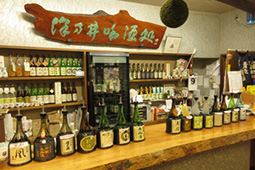INDEX

Water welling up from a horizontal well (moderately hard water) 
The main entrance to Ozawa Shuzo 
Enjoy a sake tasting at the gift shop
July 2020
Sake Created from the Abundant Nature of Ome in Tokyo

Located in Ome City, a nature-rich area on the outskirts of Tokyo, one long-established sake brewery continues in its production of sake using natural pure water and in its efforts to protect the forests that produce this water.

Ome City is in the northwestern part of Tokyo, about 1 hour by train from urban Shinjuku, and the area is blessed with abundant nature, with more than 60% of the land covered in forests. The Tama River flows from east to west through the city, and there are many places to enjoy sightseeing and recreation here. One of those places is the Chichibu-Tama-Kai National Park (see the April 2018 edition of Highlighting JAPAN). The Mitake Valley, located in a corner of the Park, produces incredibly beautiful scenery throughout the year, from the clear flow of the river and the various large and small rocks eroded by the river to the deep green in summer and the many trees steeped in color by autumn leaves in fall.
Ozawa Shuzo Co., Ltd. produces sake here along the Mitake Valley. Ozawa Shuzo was established in 1702 and has a history of more than 300 years as the westernmost of the nine sake breweries located within Tokyo. The brewery’s “Sawanoi” is a famous brand, having won numerous awards in sake contests both in Japan and abroad.

Ozawa Mikio, who became the 23rd head of the brewery in 2019, says that, “There is an abundance of clear water in this area, and it is well suited for sake production. One of the biggest characteristics of our sake is that we use two types of water: moderately hard water and soft water.”
The moderately hard water is drawn from a horizontal well located behind the brewery, created by digging out about 140 meters of bedrock by hand, and the soft water is taken from a well on the opposite side of the Tama River. While sake made using mineral-rich hard water has a strong flavor, sake made using mineral-poor soft water tends to have a light and gentle flavor. A variety of flavors of sake can be created by using these two types of water.

Ozawa Shuzo has set up a restaurant, a gift shop where you can do a sake tasting, and other facilities along the Tama River, offering sake and foods made using local ingredients. One of those foods is wasabi zuke, or pickled wasabi. This wasabi (Japanese horseradish), grown with clear water in the cool climate, has been a specialty product of the area since the Edo period (1603–1867). Pickled wasabi is created by pickling the wasabi with sake kasu, the lees produced in the process of creating sake. The refreshing spiciness of the pickled wasabi enjoyed together with sake while also watching the movement of the clear river is something special.
Up until Mikio’s grandfather became the head of the brewery, Ozawa Shuzo was also engaged in the forestry business, utilizing the abundant timber resources. Even today, the brewery manages the surrounding expansive forests that they own, but this is done for sake production. The rain that falls in the forest soaks into the ground and is purified, becoming groundwater and eventually becoming the spring water used in sake production. Destruction of the forests has a damaging effect on the water that is an ingredient in sake, so steady management of the forests is essential.

Mikio talks about how, “People from overseas come here and are amazed that a place with this much nature could be in Tokyo. I believe that it is also our role as a sake brewery to continue to protect this abundant nature.”
Together with the production of sake, efforts to protect the expansive forests have been passed on for more than 300 years.

